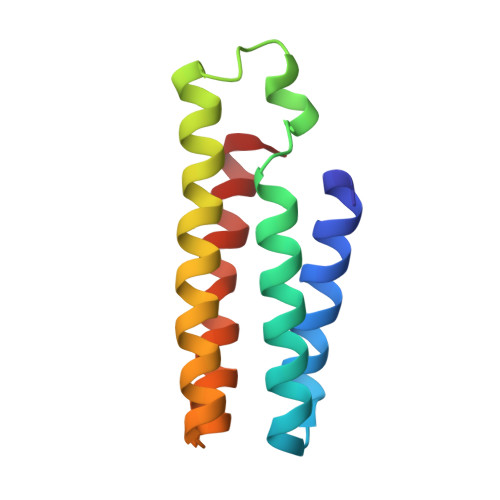Importance of Scaffold Flexibility/Rigidity in the Design and Directed Evolution of Artificial Metallo-beta-lactamases.
Song, W.J., Yu, J., Tezcan, F.A.(2017) J Am Chem Soc 139: 16772-16779
- PubMed: 28992705
- DOI: https://doi.org/10.1021/jacs.7b08981
- Primary Citation of Related Structures:
5XZI, 5XZJ - PubMed Abstract:
We describe the design and evolution of catalytic hydrolase activity on a supramolecular protein scaffold, Zn 4 : C96 RIDC1 4 , which was constructed from cytochrome cb 562 building blocks via a metal-templating strategy. Previously, we reported that Zn 4 : C96 RIDC1 4 could be tailored with tripodal (His/His/Glu), unsaturated Zn coordination motifs in its interfaces to generate a variant termed Zn 8 : A104 AB3 4 , which in turn displayed catalytic activity for the hydrolysis of activated esters and β-lactam antibiotics. Zn 8 : A104 AB3 4 was subsequently subjected to directed evolution via an in vivo selection strategy, leading to a variant Zn 8 : A104/G57 AB3 4 which displayed enzyme-like Michaelis-Menten behavior for ampicillin hydrolysis. A criterion for the evolutionary utility or designability of a new protein structure is its ability to accommodate different active sites. With this in mind, we examined whether Zn 4 : C96 RIDC1 4 could be tailored with alternative Zn coordination sites that could similarly display evolvable catalytic activities. We report here a detailed structural and functional characterization of new variant Zn 8 :AB5 4 , which houses similar, unsaturated Zn coordination sites to those in Zn 8 : A104/G57 AB3 4 , but in completely different microenvironments. Zn 8 :AB5 4 displays Michaelis-Menten behavior for ampicillin hydrolysis without any optimization. Yet, the subsequent directed evolution of Zn 8 :AB5 4 revealed limited catalytic improvement, which we ascribed to the local protein rigidity surrounding the Zn centers and the lack of evolvable loop structures nearby. The relaxation of local rigidity via the elimination of adjacent disulfide linkages led to a considerable structural transformation with a concomitant improvement in β-lactamase activity. Our findings reaffirm previous observations that the delicate balance between protein flexibility and stability is crucial for enzyme design and evolution.
- Department of Chemistry and Biochemistry, University of California, San Diego , La Jolla, California 92093-0356, United States.
Organizational Affiliation:



















